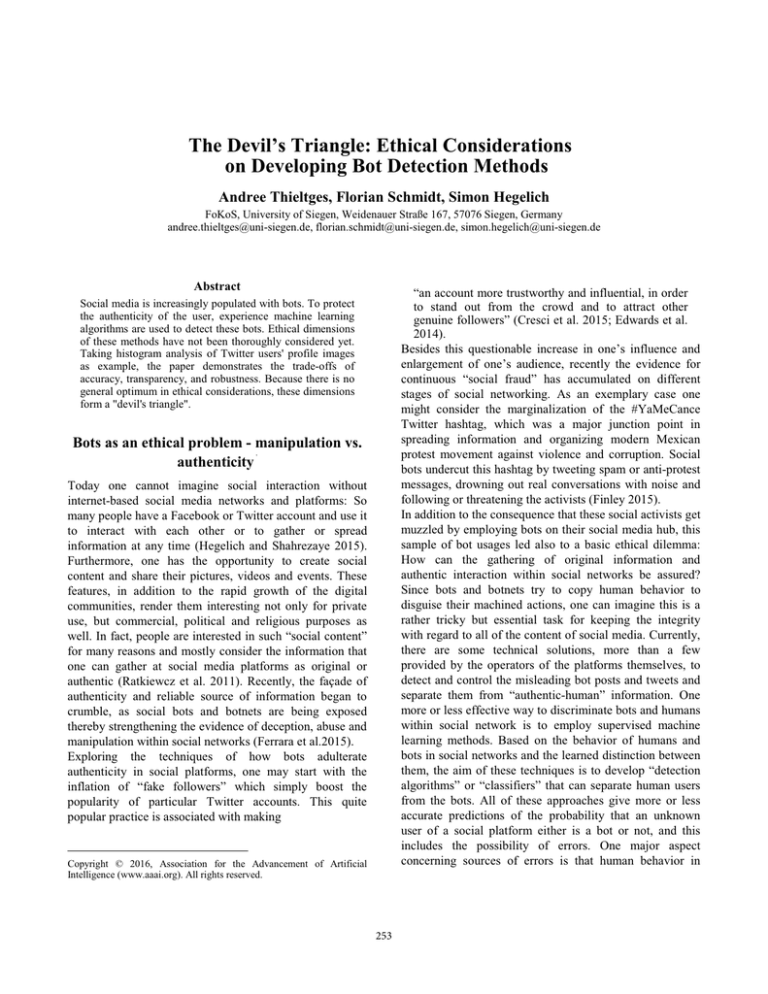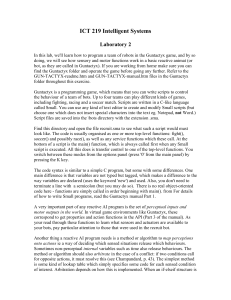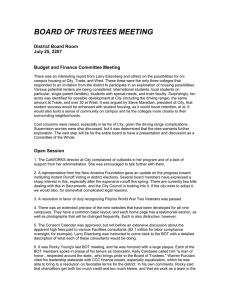
The Devil’s Triangle: Ethical Considerations
on Developing Bot Detection Methods
Andree Thieltges, Florian Schmidt, Simon Hegelich
FoKoS, University of Siegen, Weidenauer Straße 167, 57076 Siegen, Germany
andree.thieltges@uni-siegen.de, florian.schmidt@uni-siegen.de, simon.hegelich@uni-siegen.de
Abstract
“an account more trustworthy and influential, in order
to stand out from the crowd and to attract other
genuine followers” (Cresci et al. 2015; Edwards et al.
2014).
Besides this questionable increase in one’s influence and
enlargement of one’s audience, recently the evidence for
continuous “social fraud” has accumulated on different
stages of social networking. As an exemplary case one
might consider the marginalization of the #YaMeCance
Twitter hashtag, which was a major junction point in
spreading information and organizing modern Mexican
protest movement against violence and corruption. Social
bots undercut this hashtag by tweeting spam or anti-protest
messages, drowning out real conversations with noise and
following or threatening the activists (Finley 2015).
In addition to the consequence that these social activists get
muzzled by employing bots on their social media hub, this
sample of bot usages led also to a basic ethical dilemma:
How can the gathering of original information and
authentic interaction within social networks be assured?
Since bots and botnets try to copy human behavior to
disguise their machined actions, one can imagine this is a
rather tricky but essential task for keeping the integrity
with regard to all of the content of social media. Currently,
there are some technical solutions, more than a few
provided by the operators of the platforms themselves, to
detect and control the misleading bot posts and tweets and
separate them from “authentic-human” information. One
more or less effective way to discriminate bots and humans
within social network is to employ supervised machine
learning methods. Based on the behavior of humans and
bots in social networks and the learned distinction between
them, the aim of these techniques is to develop “detection
algorithms” or “classifiers” that can separate human users
from the bots. All of these approaches give more or less
accurate predictions of the probability that an unknown
user of a social platform either is a bot or not, and this
includes the possibility of errors. One major aspect
concerning sources of errors is that human behavior in
Social media is increasingly populated with bots. To protect
the authenticity of the user, experience machine learning
algorithms are used to detect these bots. Ethical dimensions
of these methods have not been thoroughly considered yet.
Taking histogram analysis of Twitter users' profile images
as example, the paper demonstrates the trade-offs of
accuracy, transparency, and robustness. Because there is no
general optimum in ethical considerations, these dimensions
form a "devil's triangle".
Bots as an ethical problem - manipulation vs.
authenticity ӄ
Today one cannot imagine social interaction without
internet-based social media networks and platforms: So
many people have a Facebook or Twitter account and use it
to interact with each other or to gather or spread
information at any time (Hegelich and Shahrezaye 2015).
Furthermore, one has the opportunity to create social
content and share their pictures, videos and events. These
features, in addition to the rapid growth of the digital
communities, render them interesting not only for private
use, but commercial, political and religious purposes as
well. In fact, people are interested in such “social content”
for many reasons and mostly consider the information that
one can gather at social media platforms as original or
authentic (Ratkiewcz et al. 2011). Recently, the façade of
authenticity and reliable source of information began to
crumble, as social bots and botnets are being exposed
thereby strengthening the evidence of deception, abuse and
manipulation within social networks (Ferrara et al.2015).
Exploring the techniques of how bots adulterate
authenticity in social platforms, one may start with the
inflation of “fake followers” which simply boost the
popularity of particular Twitter accounts. This quite
popular practice is associated with making
Copyright © 2016, Association for the Advancement of Artificial
Intelligence (www.aaai.org). All rights reserved.
253
social interaction always refers to a specific context and
therefore is rather heterogeneous. So, despite the fact that
the bots are continuously changing and evolving to keep
their camouflage, imagine the scenario of a human cyber
activist who expresses her view on a sensitive subject or
simply exchanges opinion and wishes to keep herself in
disguise for good reason 1. Hence her social media account
may show some features which are also associated with bot
accounts, for instance unusual times for system logon, a
conspicuous friend-follower-ratio, an uncommon IPaddress or simply a non-human avatar. It's quite
conceivable that some of the classifiers will mark this
human as a bot. So, the ethical dilemma mentioned above
continues somehow: One cannot be sure if the prediction
made by a machine learning algorithm is right all the time.
Thus, not only the result of a machine learning technique to
detect bots is ethically questionable, but also the decisions
that will lead to it. In the following we explore the ethical
content of a bot detection development process that
employs a machine learning method by following up on
questions about its accuracy, its transparency and its
robustness.
Figure 1: ROC Curve of the support vector machine classifier
based on the histogram analysis of Twitter profile pictures
The smaller sample (1000 items) became our training data
set (train-data), the larger one (3648 items) became our test
data set (test-data). We then continued with a supervised
learning method in which we taught our machine that there
are bot and human accounts according to the histograms
associated with each of the items in the train-data set.
Based on this separation we let it compute a support vector
machine classifier for the divisions of bots and humans.
Finally, we let our support vector machine classifier run on
our test-data set and as a result achieved 83.6% accuracy in
the separation of bot and human profile picture histograms.
Histogram analysis as a bot detection method
The basic idea arising from our continuous “bot hunting”
projects is this: Exploring new detection methods to fit the
dynamic mutability of social bots on Twitter, we diagnosed
that bots often use comic characters or icons (e.g. the egg
icon that Twitter provides) as their profile picture or avatar.
This finding raised the question of whether it is possible to
set up a framework that will scan Twitter-users by their
avatar and give a prediction whether they are bots or
human. Based on our verified bot and botnet database of
Twitter-accounts that Simon Hegelich (2016) found during
his study of Ukrainian/Russian social bots, we downloaded
all of the 1948 profile pictures of the bot accounts and
extracted and scaled them to the same size (400px x
400px). This ensures an increased comparability, since not
all of the pictures and icons are square-cut. To complete
our data set we continued this procedure with 2700
Twitter-account profile pictures from a different database
where all of the users are verified humans (like some of the
most active celebrities on Twitter). Subsequently, we
programmed an algorithm which converted every profile
picture from RGB color model into greyscale and
afterwards extracted the histogram of the picture using
Open CV. In a second step we divided our histogram data
set into two randomized samples:
Ethical questions in developing bot detection
by machine learning algorithms aka. the
devil’s triangle
Although the probability of 83.6% for a true prediction
about the profile picture belonging to a bot (TRUE
positive) or a human (TRUE negative) does not seem so
bad at first glance, there are still sources of error which
cause the algorithm to detect either bots as humans
(FALSE positive) or humans as bots (FALSE negative). As
aforementioned, one of the basic problems of feature-based
bot classifiers is that their detection results are strongly
reliant on the contextual framework of the social
interaction. For instance, if you employ our “avatar
classifier” on users that tweet within the context of the
#indicomics hashtag instead of the #euromaidan or
#maidan hashtags you are likely to get different detection
results for both humans and bots. Since machine learning
classifiers are based on observations of behavior and
1
There are now many known cases of activists who are prosecuted for
their comments or speeches on social media platforms by state authorities.
A current example may be the arrests of social media activists in the Hong
Kong uprising (Zhang 2015).
254
Robustness
Bot Variation
Imagine that somebody who has developed a classifier to
detect bots (whether it is a complex neural network or a
simple decision tree-based approach) is going to publicize
her method, features and results.
encode this behavior into features, it is possible to expand
the feature space and combine them into a more complex
classifier which will increase the quantity of the bot
detection and lower the number of the wrongly detected
humans. One may do this by taking into account the friendfollower-ratio, the number of tweets and/or re-tweets, the
duration and comparison of the access time, or even the
users’ meta data. From the ethical point of view, the
decision to create a more complex classifier is the first step
into the “devil’s triangle”:
Transparency
Transparency
Figure 4: Increased transparency will cause continuous bot
variations and a decrease in detection robustness.
Accuracy
Not long before, bot-operators will adapt their machines so
this detection algorithm becomes invalid. Speaking in
ethical terms, (too much) transparency in this case will
increase the uncertainty and the probability of
manipulation and fraud within social networks and put it
on a whole new level, because a generation of new bots
(referred to as 2.0) comes into being.
Regarding our triangle, the classifier only detects the “bot1.0” generation but cannot detect the “bot-2.0” generation,
hence the number of FALSE positive and FALSE negative
predictions will increase. Furthermore, if a new classifier is
developed to identify the new bot-2.0 generation, it must
include all the relevant features to separate three classes of
users (humans, bots-1.0 and bots-2.0) instead of two. This
represents an intrinsic source of error, since there is a
permanent danger to over- or underfit the prediction model
which is the base for the new classifier. Eventually, the
larger variance in the bot population will cause another
threat to our prediction: The fading of the robustness
against manipulation.
Robustness
Figure 2: The devil’s triangle
Accuracy
Transpiracy
Coming back to the social net activist who disguises
herself, a classifier that combines certain features will not
detect her as a human user, but carry on to treat her as a
bot, with the result that her access to the social platform
will be restricted or she will be marked as a bot. She cannot
explain herself why this happens, because she cannot
reconstruct the features that the algorithm uses to
differentiate machines and humans.
Variance vs. robustness – back to the beginning
To detect the newly formed bot generation will require an
expanded classifier, since the one that was developed in
our example only identifies the 1.0-bots. Moreover, the
detection of these bots will also diminish, in fact they will
also alter their behavior based on their advanced
knowledge of the bot detection algorithm. There will be a
larger variation in features that will work to identify bots in
the future, since not all of the generation 2.0-bots will
behave similarly. To set up an algorithm which proves to
be robust, one could probably proceed to specify the
advanced features of the new bot generation. This may
result in numerous “deductive” approaches. Or one could
try to continue with a more generic approach, by finding
universal features of the bot population. Both ways may be
Range of Features
Figure 3: Increase of the features range will enhance the
accuracy and decrease the transparency.
In other words
“it will become increasingly important to develop AI
algorithms that are not just powerful and scalable, but
also transparent to inspection – to name one of many
socially important properties” (Bostrom and
Yudkowski 2014).
Dealing with transparency
But what if one opens the black box of machine learning
algorithms which are employed to detect bots and botnets?
255
problematic according to the ratio of error one will
achieve: If one will develop a specialized algorithm it
presumably has a low rate of errors by identifying bots
which apply to the particular set of features. If one employs
this algorithm to a broader data-set i.e., the variation of the
bot features may increase and so will the sources of error.
If one computes an algorithm based on more universal
features, it may achieve a rather good rate of error by
detecting bots in general. But what if one reduces the set of
data to a set where only the bots remained that specified
their behavior? One can comprehend that both approaches
cause a higher accuracy if they employ either a broader or
a smaller set of data. Finally, we return to our zero point of
the “devil’s triangle”, starting once again by seeking an
algorithm that will increase the accuracy of our bot
detecting method and, by doing so, reduce the
manipulation in social networks.
developing a bot detection algorithm. It may sound simple
but in our opinion, the key suggestion for such a
developing process is to clarify the detection goals. To
come to a decision, our “devil’s triangle” may be a - still
quite simple - tool regarding ethical considerations and
dealing with the aforementioned trade-offs. For instance, if
one has the goal to maintain the safety of a social network
and therefore develop and employ bot detection methods,
several features to discriminate the humans and the bots
may be involved and the use of combined sets of features
may increase the accuracy of the algorithms. But not
everything that is technically feasible has to be used. In a
development process one should ask if the expansion of the
feature range is a good choice in regard to the purpose one
wishes to achieve. Moreover, to verify or falsify the benefit
of an increased feature range, every single feature of the
classifier must be reviewed relating to its purpose. In
addition, one has to take into account that the goal of
network safety may affect other crucial issues. As we
stated before, some of the ethical problems cannot be
solved. To enable oneself to include ethical considerations
in one’s decision, one should at least be aware of those
problems and this is where our “devil’s triangle” may give
support.
Conclusion
One might get the notion that bringing ethical aspects into
machine learning techniques for bot detection leads to a
never ending task: Every solution to strengthen our rate of
error, the transparency or the robustness of a given
algorithm somehow opens up another stage of ethical
problem, in other words, whatever one does is wrong. One
will get into trade-offs, since the reciprocal problems with
accuracy, transparency and robustness cannot be solved
and moreover, one cannot weight them against each other.
We showed that alternative behavior of both, human and
bot users of social platforms will get the detection methods
into trouble. Following the idea of alternative behavior,
one may approach the developing process of machine
learning techniques for bot detection under aspects of
bounded rationality: The observation of human and bot
behavior within social platforms could be considered as a
“set of behavior alternatives” that will provide reference
alternatives in choices and decisions. To specify these
behavioral alternatives, one may employ a
References
Bostrom, N. and Yudkowsky, E. 2014. The ethics of artificial
intelligence. In The Cambridge Handbook of Artificial
Intelligence, 316-334. Cambridge: Cambridge University Press
Chu, Z., Gianvecchio, S., Wang, H., and Jajodia, S. 2012.
Detecting Automation of Twitter Accounts: Are You a Human,
Bot, or Cyborg? In Transactions on Dependable and Secure
Computing 2012-11, 811-824. Washington D.C.: IEEE Computer
Society.
Cresci, S., Di Pietro, R., Petrocchi, M.; Spognardi, A. and
Tesconi, M. 2015. Fame for sale: efficient detection of fake
Twitter follower. In Decision Support Systems, 80, 56-71.
Elsevier B.V.
Edwards, C., Edwards, A., Spence, P.R., and Shelton, A. 2014. Is
that a bot running the social media feed? Testing the differences
of communication quality for a human agent and a bot agent on
Twitter. In Computers in Human Behavior 33, 372-376. Elsevier
B.V.
Ferrara, E., Varol, O., Davis, C., Menczer, F., and Flammini, A.
2015. The Rise of Social Bots. Accessed 2015-10-07.
http://arxiv.org/pdf/1407.5225v3.pdf.
Finley, K. 2015. Pro-Government Twitter Bots Try to Hush
Mexican Activist. In Wired Magazine. Accessed 2015-10-07.
http://www.wired.com/2015/08/pro-government-twitter-bots-tryhush-mexican-activists/.
Gigerenzer, G. and Selten, R. 2002 Rethinking Rationality. In
Bounded Rationality. The Adaptive Toolbox, 1-13. Cambridge,
Mass.: The MIT Press.
Hegelich, S. 2016. Are Social Bots on Twitter Political Actors?
Empirical Evidence from a Ukrainian/Russian Social Botnet. In
“subset of behavior alternatives” that the organism
“consider” or “perceive”. That is, the organism may
make its choice of alternatives within a set of more
limited than the whole range objectively available to
it.”(Simon 1955)
This may cause the implementation of features that will
respect the variety of human behavior instead of isolating
the statistical mainstream. However, developers of
machine learning bot detection methods should keep in
mind, that the – yet currently still simple – ethical
problems will remain, and that there is no “optimization
under constraints” (Gigerenzer and Selten 2002).
Nevertheless, bot detection methods have to deal with
these constraints and this may be the major task in
256
Media Bias. Tagungsband 112 der Schriftenreihe des Instituts für
Rundfunkrecht. München: Verlag C.H. Beck.
Hegelich, S. and Shahrezaye, M. 2015. The communication
behavior of German MPs on Twitter: Preaching to the converted
and attacking opponents. In European Policy Analysis Vol 1.
Number 2 – Fall 2015, 155-174. Accessed 2015-10-08.
http://joom.ag/aOgp/p154#.VhYwpdkNUJg.mailto.
Ratkiewcz, J., Conover, M., Meiss, M.; Gonçalves, B., Patil, S.,
Flammini, A. and Menczer, F. 2011. Truthy: mapping the spread
of astroturf in microblog streams. In Proceedings of the 20th
international conference companion on World wide web, 249252. New York: ACM.
Simon, H. 1955. A Behavioral Model of Rational Choice. In The
Quarterly Journal of Economics, Vol. 69, No. 1., 99-118.
Cambridge, Mass.: The MIT Press.
Zhang, J. 2015. Hong Kong’s Activist Social Media Culture
Under Threat. Activists claim that authorities are using an
ambiguous ordinance in a selective crackdown on free speech.
Accessed 2015-03-12. http://thediplomat.com/2015/06/hongkongs-activist-social-media-culture-under-threat/.
257




